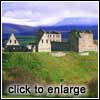|
Around Inverness
Culloden and Cawdor
Four miles (6km) to the east of Inverness following
the B9006 is the battlefield of Culloden. This could have been a rather disappointing
excursion as there is only a stretch of boggy, bracken and heather-covered land.
However, thanks to the effort of the National Trust and their excellent Visitor Centre,
the incidents leading up to, during and following this tragic battle are given their
due credit.
The Battle of Culloden
On the 16 April 1746 Prince Charles Edward Stuart
and his 5,000 kilted supporters faced the 9,000 strong Hanovarian forces under the
command of the Duke of Cumberland. Following their march to Derby, more than 200
miles (320km) beyond the English Border, and their subsequent decision to return
to Scotland, the Jacobite army, exhausted and starving as well as pursued by the
largest army ever mustered against the Scots, attempted to surprise their foes at
Nairn, some 12 miles (19km) east of Culloden. Their night march and early morning
attack failed miserably.
 Later at Culloden, facing a battery of cannon and superior
muskets with few similar weapons to reply, the Highland army was forced to attempt
their notorious, blood-curdling charge over boggy ground and through wind-driven
sleet. Later at Culloden, facing a battery of cannon and superior
muskets with few similar weapons to reply, the Highland army was forced to attempt
their notorious, blood-curdling charge over boggy ground and through wind-driven
sleet.
The Highlanders, more used to close fighting techniques
using their 'targe' (a rounded shield) and broad swords, were held off by the better-drilled
and heavily armed southern forces. Nearly 1,000 Jacobites fell and those that lay
wounded were slain where they fell. Significantly, there were only around fifty Redcoat
casualties.
Bonnie Prince Charlie, with a price of £30,000
on his head, remained hidden in the Western Highlands for five months before departing
on a frigate for France and debauched oblivion. So ended the 'romantic' tale of Bonnie
Prince Charlie and the Jacobites.
He had arrived in Scotland with only seven men and
no money to speak of and raised an army of wild clansmen who could hardly agree with
one another; yet they would follow him. He virtually walked through Scotland claiming
all as he went, he succeeded in reaching deep into England and some say he might
have been successful if he had continued to London.
The Visitor Centre admirably outlines the reasons
for and the results of the battle using historic tableaux, audio presentations and
slides. Outside, various plaques identify the clans and their positions as well as
their graves. Fenced trails lead around the moor and battle site. A flat stone marks
the supposed position from where Cumberland commanded his troops.
The 'Well of the Dead' is a site where wounded Highlanders
were slain as they attempted to take water. A restored thatched cottage, Old Leanach,
still stands, the only building to survive the battle and where 300 Highlanders were
burnt alive. It was inhabited until the beginning of the twentieth century and is
now a folk museum.
The aftermath of Culloden was almost as savage as
the battle. Cumberland, now known as 'the Butcher', had his troops scour the Highlands
and Islands for any possible Jacobite supporters, had them imprisoned or put to death,
burned cottages and raped the women, thereby ensuring no further insurgence.
The possession of weapons, wearing of the kilt and
tartan, playing of bagpipes and the use of Gaelic language were all banned, although
it was hard to enforce the latter. A propaganda campaign finally sealed the Highlander's
reputation, and everything about the Highlands became regarded as uncouth by everyone
south of the Drumochter Pass.
Not until Sir Walter Scott's very popular novels,
often set in the Highlands, the coming of King George IV in 1822 and finally Queen
Victoria in the middle of that century did this attitude change in the minds of British
people. Culloden was the last major battle to be fought on British soil.
 Continuing along the B9006 for several miles, you will arrive
at Cawdor village and Cawdor Castle, locally pronounced 'Cawdir', one of the most
romantic and commodious castles in Scotland. Still lived in by the Cawdor family,
it maintains an air of domesticity, making it more of a home than a chilly keep. Continuing along the B9006 for several miles, you will arrive
at Cawdor village and Cawdor Castle, locally pronounced 'Cawdir', one of the most
romantic and commodious castles in Scotland. Still lived in by the Cawdor family,
it maintains an air of domesticity, making it more of a home than a chilly keep.
The main tower is 600 years old with several quixotic
additions that flourish around it. This is the Cawdor of Shakespeare's Macbeth where
the character becomes Thane of Cawdor, thus fulfilling the witches' prophecy, and
encouraging him to murder Duncan to become king. One of its most pleasant aspects
is the walled garden, not so stately and formal as some but more congenial for its
simple arrangements. Be sure to obtain a copy of the castle guide book which humorously
helps to make a visit more interesting.
Nairn
Nairn is primarily a holiday town on the shores of
the Moray Firth, supposed to be known for its milder weather but in Scotland that
is a rather nebulous assertion. It is also known as the 'Brighton of the North' and
again, apart from being next to the sea, there is little resemblance. It has an old
fashioned, courteous air and was planned well in Victorian times.
There is a long, sandy beach and an over-abundance
of accommodation. Not an overly exciting place, it is perhaps best known for its
two golf courses, particularly Nairn West which is visited by golfers from around
the world. Nairn Fishertown Museum in the Laing Hall in King's Street has interpretive
displays about the old fishertown of Nairn with a good collection of photographs
from the steam drifter era. There are model boats and exhibits on the domestic and
social life of the area.
Fort George
Returning to Inverness, a diversion on the B9092 north-west
to Fort George is essential. Built on a strategic headland that juts into the Moray
Firth, less than a mile across the water from the Black Isle, this Hanovarian stronghold,
named after George II, was the final nail in the Jacobite coffin. Erected to replace
the castle at Inverness that was blown up by the Jacobites in 1746, its construction
commenced in 1748, two years after the Battle of Culloden. When it was finished in
1769 there was no longer any trace of hostility, the Highlanders suppressed beyond
sedition.
 Kept as a military barracks, which it still is today, it is
a large fortress essentially in its original condition. Ironically, many generations
of Highland soldiers have been trained within these walls and the Regimental Museum
of the Queen's Own Highlanders reflects their exploits with its collection of arms,
colours, uniforms and medals connected with every major campaign fought by the British
Army over the past two centuries. Kept as a military barracks, which it still is today, it is
a large fortress essentially in its original condition. Ironically, many generations
of Highland soldiers have been trained within these walls and the Regimental Museum
of the Queen's Own Highlanders reflects their exploits with its collection of arms,
colours, uniforms and medals connected with every major campaign fought by the British
Army over the past two centuries.
The chapel's stained glass windows include an image
of the bagpipes but the most impressive aspect of the place has to be its vigourous
military architecture, perhaps the most impressive of its kind in Europe.
|



